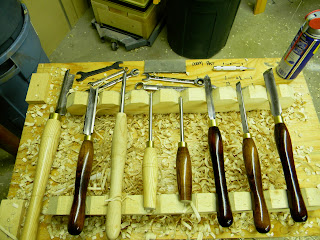Here's the basic assortment of tools I use for turning. Pretty standard stuff, really. I keep the cart right behind me and to my right ( I'm a righty) and I always put the tools back on the cart in the same place, and lately I've noticed that I can find the tool without having to look. I use the big gouge (far left) to rough out the blanks and do the heavy material removal. Next is the smaller gouge, probably the most used tool. I use it to do heavy removal, final shaping and everything in between. Then is a 1/2 gouge, almost never used, and then a couple 3/8 gouges with the handles trimmed (more on that), parting tool, and a couple of razor sharp skews. I use the open end wrenches to size tenons and the WD-40 is used after turning green wood. I spray a little on the end of the tool when I finish up for the day, it prevents rust, and aids in gunk removal.
Here you can see the different grinds on the 3/8 gouges. The one on the left works great cutting right in on a birds beak or to define a detail, but it is wicked grabby when trying to do long flowing cuts. That's where the shorter grind on the right works great. It really cuts sweet, but it's hard to do really fine detail, so I use both. A lot of guys say it's faster to use fewer tools, and while that may be true, blowing something up and having to start over doesn't exactly save time. I say use whatever you have to to get the job done. I use the skew some, but usually I finish with sandpaper after letting the piece dry for a couple days.
Here are a couple further modifications to the two aforementioned gouges. I could cut the left side bird beak cove just fine, but when I came to cut the right side, my body got in the way when I would try to switch sides, and after many frustrating transitions, out of frustration I cut the handle off (I have since seen a picture of this somewhere) and boy what a difference. Not only does my body not get in the way, but it's faster to swing the tool around. Another thing I do is point my index finger right down the shaft of the tool, it opens up my wrist, and allows faster swinging. The skews need to be super sharp, but when they start to vibrate, it's very frustrating. So I do the best I can, and then finish off with sandpaper. I should mention that I'm a good turner, but far from great. I have struggled with it from the get go, and do screw up more than I care to admit. But I can turn baluster legs now that pass muster, so I'm almost there. One great use for screwed up legs--my five year old loves to paint them, sparkly pink and sparkly purple, of course. So if you screw up some legs, give them to a kid to paint, you won't feel so bad about it. And kids love it. Win-win. Turning can be a very frustrating skill to master, keep at it and practice, practice, practice. Every skill is eventually self taught.



No comments:
Post a Comment